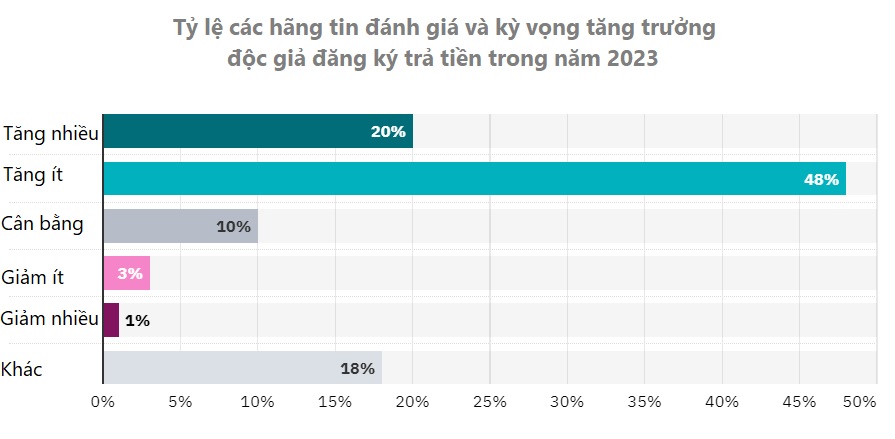World journalism and the journey to win back readers. The global economy , with its inflation and recession, has negatively impacted the world of journalism. However, to survive, the press remains determined and persistent in its quest to win and retain readers. How has this journey unfolded? What strategies, approaches, and new models are being adopted by the world's press to "win back readers"?... These are the questions raised in the special feature "World Journalism and the Journey to Reclaim Readers." |
The reality remains challenging.
Around this time last year, not long after the Russia-Ukraine conflict, a global economic crisis erupted, leading to a series of secondary crises in energy, finance, food, inflation, and more in most countries. The vast majority of people worldwide, including those in prosperous European and North American nations, had to tighten their belts on even the most essential expenses, let alone spending on newspapers.
All of this has left the world's press, already struggling after being stifled by technology platforms and social media, as well as the COVID-19 pandemic, facing an even more precarious reality and uncertain future.
When the economy declines, advertisers cut spending, and news organizations face rising costs in every area. Newsrooms heavily reliant on print media were particularly hard hit, with paper costs doubling in some regions. This could be seen as a fatal blow and may have officially sealed the fate of a number of print newspapers.
In the US, the Gannett media corporation cut another 6% of its news division, losing approximately 200 employees. The Washington Post ceased publication of its 60-year-old print magazine. CNN laid off hundreds of people, and the American broadcaster NPR significantly reduced costs and staff due to financial deficits. The picture is likely similar in many countries around the world, including Vietnam.

The press is gradually finding new ways to survive and thrive even during the most challenging times. Photo: GI
Not only print newspapers, but even online newspapers that were once very successful in the "free digital age" have declined or even collapsed rapidly, most notably BuzzFeed, which closed its Pulitzer Prize-winning news site. BuzzFeed is not alone in the decline of those still clinging to the free digital age. Another very popular digital media brand, Vice, is also following this path.
Next, once-popular news sites like Insider, Protocol, Morning Brew, and Vox are also laying off large numbers of employees and are heading towards decline. The drop in traffic due to the "reversal" of social media platform algorithms, especially Facebook, has further complicated the problem, particularly for news sites that relied heavily on social media for news dissemination.
Not only print and digital media organizations, but television stations are also facing uncertainty due to rapidly declining audiences – across all age groups – as a result of the rise of video- sharing platforms and online streaming services. The reason continues to be that most broadcasters remain overly reliant on free viewers for advertising revenue, while advertisers and users alike have flocked to video-sharing platforms and social media.
Motivation from adversity
Thus, the traditional journalism and media industry is essentially declining, and perhaps even more rapidly. However, the press will obviously not stand idly by in the face of this dire situation and bleak prospects. What can the press do to recover, or at least halt the decline? Are there any solutions?
Fortunately, the answer is yes. In theory, information is still a product that everyone needs, and it's crucial that it has value to them. This means that the press must create products that are valuable to society, in its region, or even within its own small community, depending on the newspaper's model and specifics. How to achieve that, however, is a long journey with no single answer that applies to everyone.

Journalism needs to continue diversifying its methods of conveying information and become more qualitative in order to create works that are truly valuable to readers. Photo: GI
In fact, the trend of journalism returning to the way it operated in the print era, where readers paid to buy newspapers, has been flourishing worldwide in recent years and is increasingly proving to be the path by which journalism can save itself.
Specifically, top-tier news outlets are experiencing continued growth in digital subscriptions, paywalls, and donations. “We added 70,000 subscribers last year,” said Edward Roussel, Head of Digital at The Times of London. Many other news outlets are also reporting strong growth in paywalls and paid subscriptions. The New York Times alone has seen subscription revenue increase by more than 10% and is aiming for 15 million subscribers by 2027.
However, a problem now arises, according to data from media consulting firm FIPP, that subscription growth may be nearing saturation. FIPP President James Hewes said that as winter approaches, we may “feel the chill of the freezing.” Nevertheless, according to experts and recent surveys, the paid subscription market for newspapers remains very promising in the short and medium term.
According to analyses and current global trends, the immediate task for successful paid news organizations worldwide is to focus more on retaining existing readers rather than acquiring new subscribers. This is due to the aforementioned "saturation." However, precisely because of this, finding ways to attract new readers and regain the trust of existing ones is crucial for long-term survival.
It's time to wake up and win back your readers.
In other words, it's time for journalism to wake up, win back old readers, and seek out new ones. Undoubtedly, this is a matter of life and death for journalism in the future. Just like every other aspect of life, from a product to an art form, journalism only has a future if it gains the acceptance of a wide readership, especially the younger generation.
But the crucial question is how and in what way will this journey unfold? First and foremost, it must be stated that this is also a major question, requiring the cooperation of everyone if concrete solutions are to be found.
New hopesA survey reveals that news organizations worldwide are finding new motivations to rediscover readers willing to pay for journalistic products. This data comes from a survey of 303 media leaders in 53 countries on the “Trends and Predictions for Journalism, Media and Technology in 2023” by the Reuters Institute for Journalism and the University of Oxford.  |
However, there are some basic models for re-engaging readers that are proving successful worldwide. First, offer discounts and special promotions to encourage readers to subscribe and pay for your articles. This is particularly relevant in the current context, where economic crisis and inflation continue to weigh heavily on the wallets of most people around the world.
In late 2022, the Washington Post offered a 75% discount on subscription fees, while the LA Times and Chicago Tribune offered six months of digital access for just $1. Other major publications included the New York Times, which typically offered $1 a week for the first year, and the Wall Street Journal, among many newspapers providing cost-effective options for students.
This is seen as a long-term strategy, as it may reduce news organizations' revenue but will attract the maximum number of potential readers willing to pay to read the newspaper. This tactic is being particularly adopted by European news agencies and is fostering hope that one day journalism will flourish again with added motivation.
A hopeful piece of news for the press is that, according to data from the global trend research organization GWI, after decades of continuous growth, we are beginning to see a decrease in the amount of time spent online, meaning readers in general are gravitating towards something higher quality and less chaotic . Specifically, total internet usage time has decreased by 13%, after reaching record highs during the COVID-19 pandemic. This is a crucial shift that the press needs to recognize.
According to a survey by the Reuters Institute for Journalism and the University of Oxford, approximately 42% of news organizations reported an increase in annual website traffic, while 58% reported that traffic remained unchanged or decreased. These figures are not conclusive, but they clearly indicate that the future is not entirely bleak.
The reality, which many people can probably recognize, is that readers have begun to get fed up with or afraid of the sensationalist , attention-grabbing , addictive , harmful, and especially misleading information that is rampant on social media. They are ready to return to print media, provided that it is genuinely good and offers suitable solutions to help readers easily access information.
Leverage technology and improve quality.
This means journalism needs to be better, more diverse, flexible, engaging, and insightful. Like a product, journalism needs to have its own unique characteristics in order to attract readers. In a recent study, the media consulting firm INMA found that 72% of news brands have begun developing their own journalistic positioning strategy or principles.
The Spanish newspaper La Vanguardia emphasized the phrase "truth is the first victim of war" when selling subscriptions. Vox Media stressed its mission of readily providing information to its readers. The Guardian highlighted its independent and courageous journalistic work. Newspapers should create their own slogans and do their best to fulfill their missions.
Distinctiveness doesn't mean a lack of diversity. The diversity lies in how information is presented and its sources are presented, making it as engaging as possible for readers. The New York Times now offers a package combining news with cooking apps, games, and other useful services. This means that by subscribing, readers not only access news but also enjoy many other benefits.
In Norway, the leading daily newspaper Aftenposten offers a package that includes free access to other national and regional newspapers with which it is affiliated or collaborates. Revenue and product diversification remains a top priority for news publishers worldwide. In short, journalism cannot stand still, not even for a day, in the digital age and the upcoming age of artificial intelligence (AI).
To become more diverse and appealing, successful newspapers also need to continue investing in technology. Effective use of Big Data and AI will help newsrooms better understand their readers, thereby meeting their needs. News delivery methods also need to be more engaging and technologically advanced, through algorithms and new formats, from podcasts, video, live streaming, email, apps, and other automated news delivery software.
Thus, although the world of journalism and media in general is still on a downward trend, it seems to be at the bottom of a sine wave. If the opportunity is seized, journalism can absolutely break through and usher in a new cycle of success!
Hai Anh
Source





![[Photo] Prime Minister Pham Minh Chinh presides over a meeting on private sector economic development.](/_next/image?url=https%3A%2F%2Fvphoto.vietnam.vn%2Fthumb%2F1200x675%2Fvietnam%2Fresource%2FIMAGE%2F2025%2F12%2F20%2F1766237501876_thiet-ke-chua-co-ten-40-png.webp&w=3840&q=75)


































































































Comment (0)